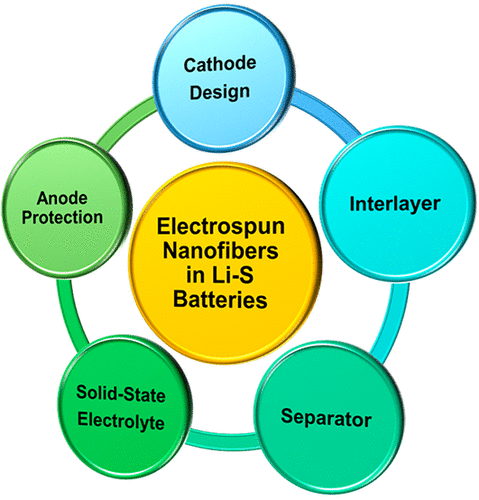当前位置:
X-MOL 学术
›
Acc. Mater. Res.
›
论文详情
Our official English website, www.x-mol.net, welcomes your
feedback! (Note: you will need to create a separate account there.)
Electrospun Nanofibers Enabled Advanced Lithium–Sulfur Batteries
Accounts of Materials Research ( IF 14.0 ) Pub Date : 2022-01-04 , DOI: 10.1021/accountsmr.1c00198 Jiadeng Zhu 1 , Hui Cheng 2 , Pei Zhu 2 , Ya Li 3 , Qiang Gao 4 , Xiangwu Zhang 2
Accounts of Materials Research ( IF 14.0 ) Pub Date : 2022-01-04 , DOI: 10.1021/accountsmr.1c00198 Jiadeng Zhu 1 , Hui Cheng 2 , Pei Zhu 2 , Ya Li 3 , Qiang Gao 4 , Xiangwu Zhang 2
Affiliation

|
Lithium–sulfur (Li–S) batteries have been extensively studied because both S and Li have high theoretical capacities, and S is abundant and environmentally friendly. However, their practical applications have been hindered by several challenges, including poor conductivity of S and its intermediates, shuttle effects of polysulfides, Li dendrite growth, etc. Tremendous efforts have been taken to tackle these issues by developing functional S host materials, separators and interlayers, solid-state electrolytes, etc., during the past decade. Compared to structurally complicated materials and intricate preparation approaches, electrospun nanofibers have obtained tremendous interests since they have played an extremely crucial role in improving the overall performance of Li–S cells due to their unique features such as easy-setup, substantial surface area, outstanding flexibility, high porosity, excellent mechanical properties, etc.
中文翻译:

静电纺丝纳米纤维使先进的锂硫电池成为可能
锂硫 (Li-S) 电池已被广泛研究,因为 S 和 Li 都具有较高的理论容量,并且 S 丰富且环保。然而,它们的实际应用受到了一些挑战的阻碍,包括 S 及其中间体的导电性差、多硫化物的穿梭效应、Li 枝晶生长等。通过开发功能性 S 主体材料、隔膜和在过去的十年中,夹层,固态电解质等。与结构复杂的材料和复杂的制备方法相比,电纺纳米纤维因其易于设置、
更新日期:2022-01-04
中文翻译:

静电纺丝纳米纤维使先进的锂硫电池成为可能
锂硫 (Li-S) 电池已被广泛研究,因为 S 和 Li 都具有较高的理论容量,并且 S 丰富且环保。然而,它们的实际应用受到了一些挑战的阻碍,包括 S 及其中间体的导电性差、多硫化物的穿梭效应、Li 枝晶生长等。通过开发功能性 S 主体材料、隔膜和在过去的十年中,夹层,固态电解质等。与结构复杂的材料和复杂的制备方法相比,电纺纳米纤维因其易于设置、







































 京公网安备 11010802027423号
京公网安备 11010802027423号